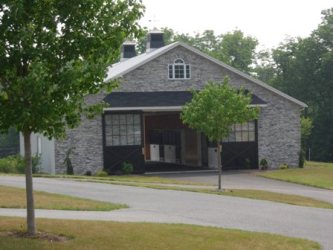Highways, Entrances, and Parking Areas
Several issues must be addressed before the client steps onto the property. In either a public or private facility, visitors should be able to park fairly close to the office in order to avoid several potential situations, including: 1) vehicles endangering mounted riders, 2) unsupervised visitors around the facility, 3) overlapping horse and vehicle traffic areas, and 4) improper containment for unexpected loose horses. A loose horse should not be able to reach the public roadway or stable parking area.
Key Point: If you do not have an adequate perimeter fence and/or gate system, do not allow inexperienced, underage, or lesson clientele to ride outside of a secured riding ring or area. A simple protocol that dictates leading horses in-hand to the arena can circumvent this facility issue.
Customers, Visitors, and Family
Whether the barn is large or small, the guidelines are much the same for the supervision of clientele. Because riding students, especially minors, are often inexperienced, it is the responsibility of the owner/instructor to maintain a safe environment for all users. Since it is common for parents to “drop off” their children for lessons, special provisions must be made to ensure that children are not a danger to themselves or others.
Barn visitors love to scratch, pet, and feed horses. Most parents would not allow a child to run up and pet a strange dog but do not hesitate to let the child pet a strange horse. Children have a natural affinity for horses but do not possess the experience to avoid inherently dangerous situations. Therefore, some provision must be made to safely accommodate small children. Children should NEVER be left unattended, and children 6 years of age and under need in-hand supervision. Adult and youth visitors (friends or strangers) must be willing to follow barn rules. To avoid problems, it is best to keep the horses well apart from the general areas of foot travel.
In a public barn, visitors and clientele should find it easy to go first to the office where they can sign releases and get a copy of the barn rules before entering the barn area.
Key Point: Unsupervised visitors or guests may act improperly around animals due to ignorance about normal horse instincts and behavior. This may lead to a horse “spook,” bite, or kick of the visitor or clientele (and liability).
Trailers, Machinery And Tools
Facilities must always be arranged to accommodate the least skilled rider anticipated. While it is convenient to have trailers near the stables to load or unload equipment and horses, it is not necessary or desirable to store them there. The same is true for tractors, mowers, arena maintenance equipment, and most other tools. All machinery can pose a huge risk to a rider on a frightened horse. While most horses can and do become accustomed to common machinery, the young or uninitiated animals need some time. All too often, a new horse in the barn is terrified of the harrow that seasoned horses walk by without a second glance. Alternatively, a change in positioning or light on the harrow may result in a spook in even the veteran school horse.



